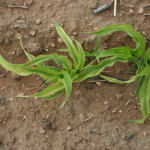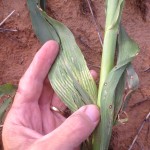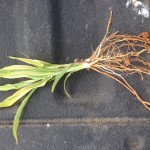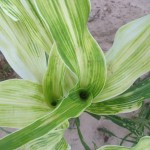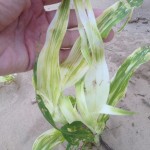by Dr. Calvin Trostle, Extension Agronomy, Lubbock, 806-746-6101, ctrostle@ag.tamu.edu
May was the wettest to third wettest month on record in many counties in West Texas. Due to earlier rains and early sorghum prices substantial grain sorghum was planted early this year to take advantage of early moisture, adequate soil temperatures for germination, and grain sorghum pricing that remains equal to corn.
Then the May deluge came:
We have seen about all the symptoms on grain sorghum in the field you could expect to see. Stunting. Yellow older leaves. Yellow younger leaves. Striping. Even near paper white leaves. Some stunted roots. The first concern in numerous fields was, apart from the foliar symptoms, what uniformity of establishment and growth was achieved across fields. Whether poor establishment or standing water, many fields have demonstrated a mix of growth and development. In some cases good plants in a portion or the field—or even within a single row—have demonstrated excellent growth and are now 18-24” tall, and a few fields even have flag leaf. But another sorghum plant even just a few feet away has struggled, and we observed numerous plants through mid-June that were 40-45 days old, physiologically at the 8-leaf stage, but the plants were only 5 or 6” tall.
Our advice over the past several weeks has been generally to replant these thin areas of older fields. Though grain sorghum growth and development is normally heat driven (i.e. heat units) we are unsure about the prospect of small plants entering growing point differentiation, and likely setting a potential head size that is small and of low yield potential. But keep in mind that a sorghum stand in West Texas with as few as 20,000 healthy plants per acre—even if irrigated—is a “keeper” in lieu or replanting. This is especially true for dryland, provided the plants are somewhat uniformly distributed across the field.
Drying Soils and Expanding Root Volume:
When a lot of foliar symptoms appear in young grain sorghum and wet conditions have prevailed (as Dr. Schnell has also discussed for Central Texas), once drying conditions return and root volume expands, many apparent foliar nutrient deficiencies take care of themselves. When these symptoms appear they are often on the youngest leaves, and with improving conditions we look for the emergence of new leaves in the whorl that return to normal coloration (less striping and a more uniform color of light to mid-green). As conditions in numerous West Texas fields dried out in mid-June, we actually saw some foliar symptoms get worse. We are not sure why.
What about herbicide damage?
Virtually every picture that we have received and every plant that was brought to us, if there was a question then we shared these with Dr. Wayne Keeling, AgriLife Research weed scientist, Lubbock. Many of these pictures and samples came to us with an assumption of herbicide damage from atrazine, propazine, or metolachlor (Dual). No, no, and no. Dr. Keeling has seen little if anything to suggest that herbicides have played a role in stunted and discolored grain sorghum. In fact, though herbicides vary greatly in their ability to move in the soil, Dr. Keeling has noted that the excessive rain likely diluted any potential injurious effect of herbicides. Furthermore, he and others have noted that flushes of weeds are appearing sooner than normal in many sorghum fields indicating that pre-plant/pre-emerge weed control efforts are fading more quickly than normal due to the excessive rainfall.
Iron (Fe) Deficiency:
This is our first and most common nutrient deficiency issue in grain sorghum. Classic iron deficiency has green veins in the leaf with yellow in between, hence “interveinal” chlorosis (Fig. 1). This is an issue in much of Texas wherever high pH soils occur, especially once soil pH reaches about 7.7 and up to 8.2. Notice the caliche or calcium carbonate fragments in Fig. 1—that tells us “high soil pH”, and when it is bad enough we don’t grow grain sorghum. This iron deficiency is on younger leaves (iron is not mobile within the plant), and eventually green growth returns whether from expanding root volume (if saturated) or application of iron materials. Sorghum is weak at iron acquisition unlike sister Graminae grasses corn, wheat, oats, and rye.
In severe cases foliar iron products can be sprayed to alleviate iron deficiency. This could include simple iron sulfate (FeSO4) if available coupled with a sticker, or the more expensive iron chelate materials. For further guidance on foliar iron sprays, consult the fertility sections of either the West Texas or the Central/South Texas pocket grain sorghum production guides from United Sorghum Checkoff Program, which were prepared by Texas A&M AgriLife, http://sorghumcheckoff.com/for-farmer/production-tools/
Other Foliar Sorghum Nutrient Symptoms:
Common on many grain sorghum samples in the Texas South Plains this year is partial interveinal chlorosis that is restricted to the lower leaves (Fig. 2). Because this is only a portion of the leaf, one might conclude this is related to an environmental event or herbicide. I have seen this before in grain sorghum, and I have no consensus among colleagues as what the issue might be. The literature suggests that both zinc deficiency and sulfur deficiency symptoms can include striping in the lower portion of the leaf, but limited foliar testing has not consistently supported this conclusion. When the symptoms in Fig. 2 first appeared, they are on younger leaves, but they seem to be more noticeable as the leaves age. Fortunately, in this particular plant younger leaves above the symptom are normal, so we haven’t been concerned further about what might have caused this common symptom. But we would sure like to know.
Apart from simple iron deficiency, however, the more common grain sorghum condition in West Texas in 2015 are represented in Fig. 3 where, yes, iron deficiency is evident, but there is a more general overall poor health and broad general yellowing of the plant. What is the cause?
• Lack of nitrogen due to all the rain leaching available N? Perhaps, but a small plant like this hasn’t required much N yet. Fortunately the roots look good.
• Low Zn or S a compounding issue?
With this June 12 plant—which is already at leaf stage 7 (the first coleoptile leaf with the rounded tip is now brown, but that is leaf 1; the collar has formed on leaf 7) will it recover? Will it have sufficient yield potential? Very many of these plants don’t give us much confidence, and so as noted above, spot replanting was recommended or even whole fields.
Additional symptoms, which manifest themselves in Fig. 4 suggest that a general iron deficiency is present as the interveinal chlorosis extends the length of several leaves. But have environmental conditions simply compounded iron issues? Or again, is there something else going on? Fortunately, as we often look for in symptomatic sorghum, in Fig. 4 the most recently emerged two leaves (the youngest is very small and still almost completely within the whorl) have darker green which suggests the sorghum is moving past current field limitations, nutrient or otherwise.
Finally, the worst of sorghum leaves demonstrates almost complete bleaching of some portions of the leaf (Fig. 5). Severe iron deficiency can do this, and if there is an obvious causal factor like a caliche soil (in this case there was), overcoming nutrient deficient conditions may be difficult. You can spray foliar iron twice and not be sure you improved the crop. That doesn’t mean that a farmer shouldn’t replant the field as the recovery from acute iron deficiency is difficult, but the overall condition of the plant in Fig. 5 is also the result of saturated field conditions which the replant crop will not likely experience, so perhaps a replant sorghum doesn’t get behind. It may do OK.
Foliar Tissue Testing of Grain Sorghum and Other Crops–Reliability:
Farmers, crop consultants, fertilizer dealers, and farm supply services may collect samples for tissue testing. Unlike corn and cotton in Texas, where there may be more developed criteria for plant tissue nutrient levels and their implications for plant health, for a crop like grain sorghum there is not a standard or consistent guideline on how you should do this. Young leaves, old leaves, whole plants? Furthermore, extraction methods for the plant tissue nutrient content may differ and give you different values. And that may not be the right value to compare to a chart that offers a range of nutrient content from deficiency to excess. So what to do? If you decide to tissue test, call the lab who will run your test and ask them how they test and how they will determine what a level of deficiency or sufficiency would be? And ask them if they include any state testing research in their interpretation of test results. Stage of growth can significantly affect tissue test results so ask about that, too. One reference that I use, though it dates from the 1980s, when examining plant tissue tests for grain sorghum is “Nutritional Disorders of Grain Sorghum,” a joint publication of Australia and India which describes nutrient levels at different growth stages, see http://ageconsearch.umn.edu/bitstream/118045/2/2.pdf

Calvin Trostle
Professor and Extension Specialist
Lubbock, TX
803.746.6101
ctrostle@ag.tamu.edu
